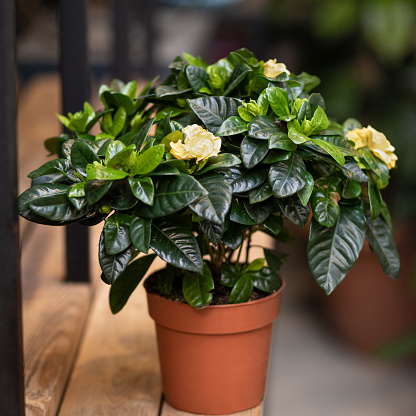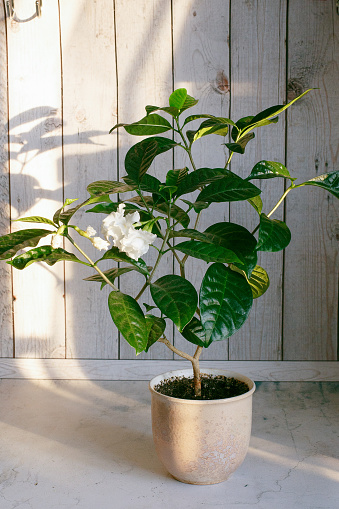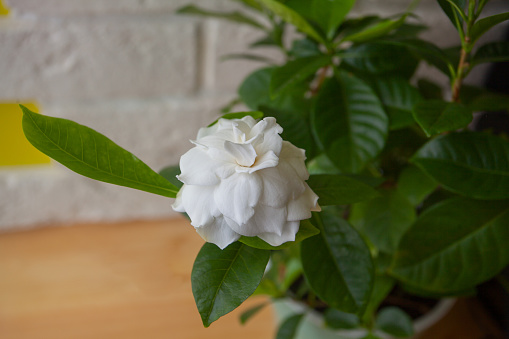Gardenia as a Houseplant— A Guide for Beginners in Growing and Caring Gardenia Indoors!
Have you ever had a houseplant with flowers? If you have not, then this is your opportunity to try one. Gardenias are gorgeous and fragrant flowers that grow best in the tropics. Their scents make them an excellent addition to any house or office environment. This guide provides you with tips on how to grow and care for gardenias as houseplants so that you can grow these beautiful flowers at home.

Table of Contents
The Right Pot for Your Gardenia
Many types of pots can be used for growing plants, but the best type of pot for a Gardenia is a clay pot. Clay pots are porous and allow water and air to circulate freely, essential for plants because they need both water and air to grow. Clay pots also retain moisture better than other pots, which is necessary for gardenias because they are prone to drying out. Another benefit of using clay pots is that they are easy to clean. Just give them a good scrub with some soap and water, then let them dry out completely before storing them away. Clay pots also have a high thermal mass, which means they retain heat well and don’t become too hot or cold in the summer or winter. This is important because gardenias like warm temperatures and don’t do well in cold climates.
Still, you can use any pot as long as it has good drainage. This will allow the plant to get enough water and nutrients while preventing excess water from sitting in the pot and causing root rot.
Another essential factor to consider when choosing a pot for your Gardenia is the size. Make sure the pot is large enough to have plenty of room to grow but not so large that it becomes difficult to care.
Finally, make sure the pot has a well-fitted lid so that you can keep the plant in at night or when it rains.
Ideal Light Conditions and Humidity Level
The ideal light conditions for your indoor Gardenia are not direct sunlight and a moderate to high humidity level.
Indirect sunlight is the best type of light because it provides your plants with the most energy. This type of light also helps keep your plants healthy by providing them with essential nutrients and promoting growth.
Gardenias like high humidity levels, so you can place the plant in the corner of your room with some humidifier running. Be sure to keep an eye on the humidity level and adjust as needed. A moderate to high humidity level is important because it helps prevent your plants from drying out. It also helps to keep your plants healthy by preventing fungal growth and protecting them from pests.

Best Location For Gardenia Plants
A south-facing window can enjoy at least 6 to 8 hours of sunlight a day. So, this can be ideal for your Gardenia, who loves the sun. Just try not to put it directly as it can cause leaves to burn, especially in the afternoon.
Best Soil For Gardenias
Always test the soil before you plant anything to ensure that it is at the correct pH level and has the proper nutrients. The pH of the soil should range between 4.5 and 6.0. Add organic matter such as compost or aged manure to the soil before planting your gardenias. This will help improve the texture and fertility of the soil.
How To Water Gardenias
Watering Gardenias is an important task that needs to be done regularly to keep the plants healthy and thriving. Here are some tips on how to water gardenias:
- Check the soil moisture level before watering. If the soil is dry, wait until the next day before watering. If the soil is wet but not too wet, give the plants a light watering. If the soil is very moist, wait until it dries out completely before watering again.
- Watering should be done at least twice a week during the summer months and once a week during the winter months. Make sure to water deeply and evenly so that all of the plant’s roots are moist.
- Do not over-water or allow rainwater to accumulate in the planting area; this can cause root rot and other problems with your plants.
Gardenia Temperature Needs
Gardenias do best in climates that are warm and humid. They need a temperature range of 65- 75° F to thrive. If the temperature is too cold, the plant will suffer from chilling injury, which can cause yellowing and dieback of leaves. If the temperature is too hot, the plant will experience sun scorch, leading to leaf damage and death.
Pruning
It would be best if you pruned your indoor Gardenia every two weeks during the growing season and once a month during the winter months. Pruning your Indoor Gardenia is an important part of keeping it healthy and looking great. Here are some tips on how to prune your indoor Gardenia:
- Before you start pruning, make sure that the plant is in good condition. If the plant is sick or damaged, it will not respond well to pruning.
- Remove any dead or diseased branches from the plant’s stem.
- Make cuts at a 45-degree angle away from the branch, making sure not to cut into the wood of the branch.
- Cut off all branches that are growing too close together or crossing over other branches.
- Leave one or two healthy branches on each stem to help support the weight of the flower head during the flowering season.
What to Do with Cuttings After Pruning?
Take cuttings from healthy plants and root them in water before placing them in a bright location indoors where they can receive direct sunlight (not in direct sunlight).
Do Gardenias Need Fertilizer?
There is no need to fertilize gardenias as they are flowering plants. However, if you would like to keep them healthy and vigorous, you may want to give them a small amount of fertilizer every couple of months.
When To Re-pot Gardenia?
There is no definite answer to this question as it depends on the individual’s gardenia needs and preferences. Repotting a gardenia should be done every two to three years, depending on the size and type of the plant. If the roots of your Gardenia have almost filled the container, it is time to repot it. The most obvious sign that your plant has outgrown its container is the presence of roots sprouting from the bottom of the container. Repotting a plant in the spring allows the roots to establish themselves in the new potting mix fully.

Gardenia Houseplants Pest and Disease Control
Some pests and diseases can affect gardenias. Some of the most common problems include aphids, spider mites, whiteflies, mealybugs, scale insects, and thrips.
To prevent these pests and diseases from damaging your gardenia plants, you will need to take some steps to control them. Some of the methods that you can use to control pests and diseases include:
- Use a balanced fertilizer that is specifically for houseplants.
- Remove any weeds or debris from around the plant.
- water your plants thoroughly but avoid wetting the leaves or flowers.
- apply a dusting of insecticidal soap to the leaves every week in late summer or early fall when aphids are most active.
- spray your plants with a contact insecticide if you see signs of infestation, such as spider mites or aphids on the leaves.
Is It Poisonous To Keep as a Houseplant?
Gardenias are not likely to cause severe health problems if kept as houseplants. It can be poisonous if they are swallowed and in contact with the skin. A known example of Gardenia species that can be slightly toxic is the Gardenia jasminoides. If swallowed, it can cause hives, vomiting, and diarrhea to dogs and horses.
Benefits of Gardenia as Houseplant
Gardenia is a popular houseplant that is known for its beautiful flowers. Gardenias are easy to care for and have a long lifespan. Some of the benefits of gardenias as houseplants include:
- It frequently blooms, producing beautiful flowers.
- Their flowers are fragrant and can be used in arrangements or as part of a fragrance plan for your home.
- The fragrant flowers can attract pollinators such as bees and butterflies.
- They are suitable for people with allergies because they do not produce latex or dander.
- Its leaves are shiny and green, making great additions to any room in the home, as they look great with any décor.
- Depending on the climate, they require little water and can be watered once a week or less.
- They have a moderate growth rate and will not take up a lot of space.
Gardenia Varieties That Can Be Grown as Houseplants
Many gardenia varieties can be grown as houseplants. Some of the most popular gardenia varieties for indoor growing include:
Gardenia jasminoides ‘Radicans’ – A dwarf gardenia that only grows 24 to 36 inches (61-91 cm) tall. The 2 to 3 inch (5-8 cm) single petaled blossoms are creamy white. Radicans, like their larger siblings, are aromatic and blooms later in the season, making it an excellent match for earlier blooming varieties.
Gardenia jasminoides ‘Kleim’s Hardy’ – it’s a hardy gardenia that grows 2 to 3 feet tall. Each flower has six solitary petals and vivid yellow stamens. The growth is spherical with big, shiny leaves.
Gardenia jasminoides ‘Buttons’ – There is a button in the middle of the two-inch semi-double flowers, which is why they are called Gardenia ‘Buttons’. This dwarf cultivar has a bushy growth pattern, ideal for pots.
